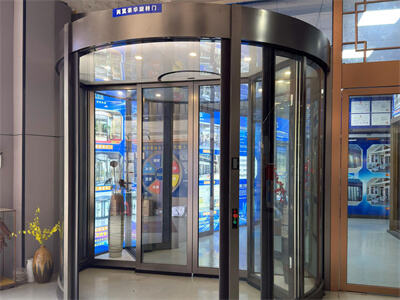Entry doors belong to the most important functional aspects that influence the user experience and have a serious effect on the energy efficiency of buildings. Use of automatic revolving doors and sliding doors is also very common, each with its own advantages and limitations. It is always essential to take into consideration the needs of your particular building in terms of space limitation, energy efficiency, accessibility, security, costs and aesthetics of design when it comes to choosing the best solution.
1. Space Constraints: Which Door Fits Tight Areas Best?
● Sliding Doors Win. Sufficient clearance is not a requirement of their operations and thus, they are suitable in narrow entrances or in buildings where the lobby areas are limited. They move horizontally in the door frame and they maximize usable space on the floor.
● Revolving Pointers Require Space. Revolving doors require much more space in terms of the diameter and depth of the floor because of circular movement of the doors. Those are most appropriate to larger structures that contain a large entrance hall.
2. Energy Efficiency: Which Door Saves More on Heating/Cooling?
● Revolving Doors Excel. The constant rotating chambers form an extremely efficient airlock separation, reducing air flow in and out of the interiors by huge proportions. A lot of energy, which is used in heating and cooling systems, can be lost due to this containment hence a lot of savings are achieved in terms of operations expenses.
● Sliding doors have a lower level of insulation. Every opening leaves a vast opening, through which much conditioned air can flow out and much unconditioned air can flow in and influence the indoor thermal stability. This is countered with energy-efficient models (with either double-pane glass or low-emission layers) but they fail to, by force, perform as well as revolving doors with their airlock nature.
3. Accessibility: Which Door Is Easier for All Users?
● Sliding doors have better ease of use. They operate fully automatically using motion sensors thus offer an easy barrier-free passage. This is especially beneficial to those who wear wheelchairs, walkers or are carrying things and the overall movement of pedestrians.
● The revolving doors may be difficult. The rotating compartments need greater interaction and coordination among the users hence it may result in a bottleneck during rush hours. This has however changed due to the adoption of new technologies in modern automatic revolving doors which have variable speed achievable to flow and convenient access to pedestrians, compared to the older manually operated ones.
4. Safety & Emergencies: Which Door Offers Better Performance?
● Sliding doors are made with strong safety measures. They are fitted with complicated sensors, which can sense obstacles reliably and consequently reverse automatically or stop to avoid hits. Most newer sliding doors have a break out panel/mechanism which enables the doors to swing out easily when pressurized; these doors therefore enable rapid exit in case of emergencies.
● There Are Challenges of Revolving Doors. During an evacuation of a lot of people, the enclosed sections of revolving doors may become necked or dangerous. Although they as well possess safety sensors, what they are designed to do has a limit to the ability to be opened simultaneously in comparison to that of wide-open sliding doors and to breakout panels. Adequate planning and possible follow-up exits can be required.
5. Budget: Comparing Installation & Lifetime Costs
● Sliding doors tend to be cheap to procure initially. The fact that they have a simpler mechanism usually means less initial purchase and installations. They are also mostly less intricate and expensive to maintain.
● The Cost of Revolving Doors are Higher on Capital Investment. They have highly complicated mechanics resulting in a much higher initial price and in a lot of cases even extensive maintenance. But certainly their lower energy consumption can subsequently cover up the difference of the initial cost by long-term operational savings as far as extreme temperatures are considered.
6. Design & Branding: Which Door Makes a Stronger Statement?
● Revolving Doors Convey Prestige & Permanence. They have been used in luxury hotels, high-end corporate headquarters and large public buildings, where an image of sophistication, stability and modernity is emitted, making a forceful architectural statement.
● Sliding Doors are Mounted in Sleek Variety. They have clean lines and large windows of glass that offer a modern minimalist look which blends in well with modern buildings. They also provide a more broad option on the materials used (glass, metal, wood) to match varied design types.

